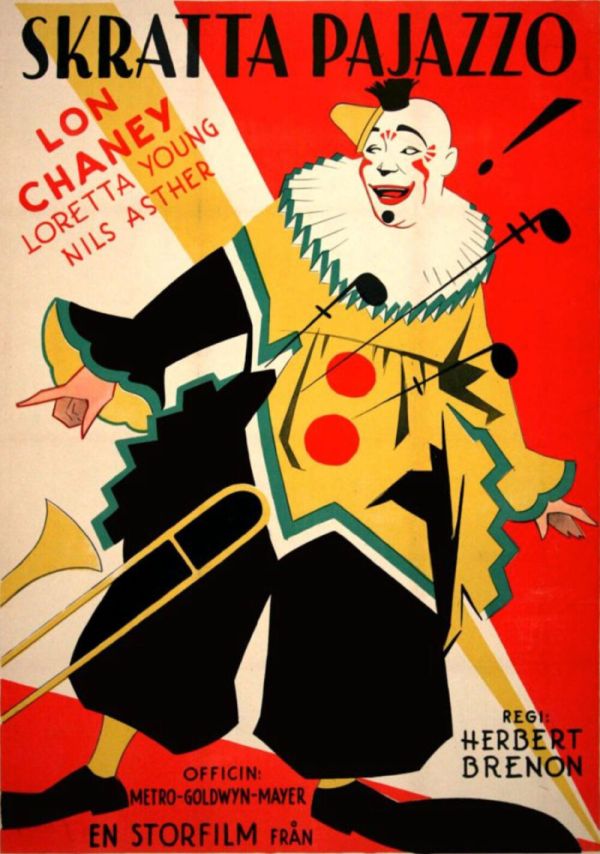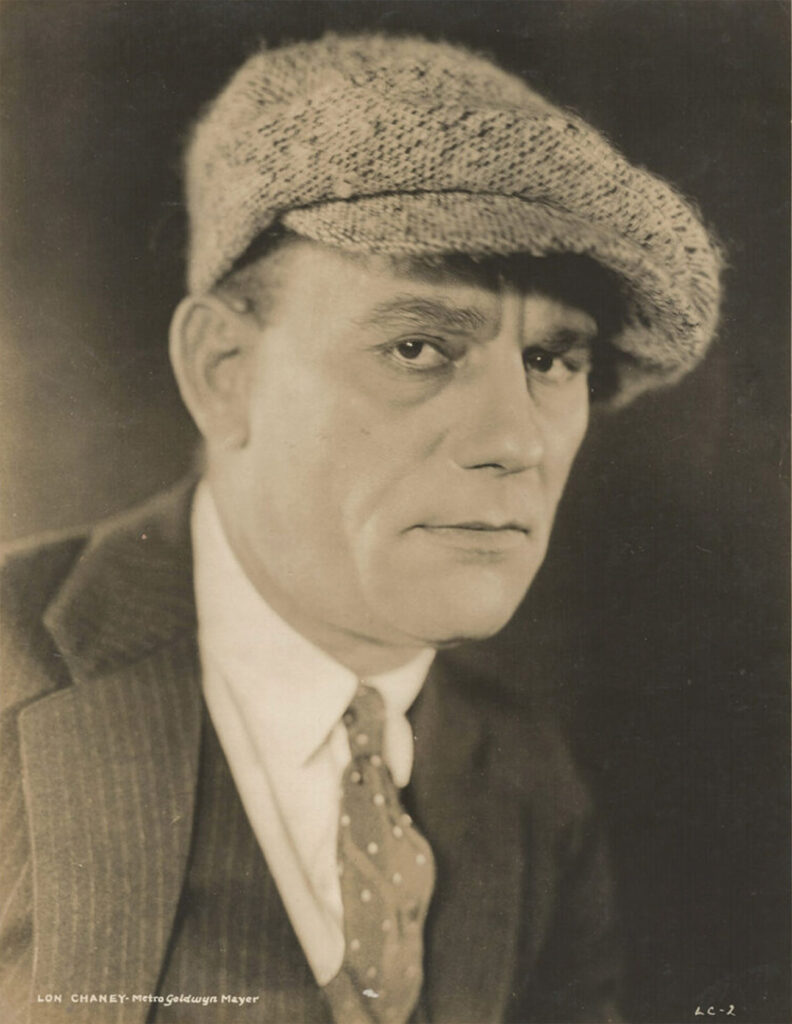
Lon Chaney – Man Of Many Faces
THE ABOVE PHOTOGRAPH – Vintage original 27 x 38″ (70 x 98 cm.) poster, Sweden. Lon Chaney, Loretta Young, Nils Asther, Gwen Lee, dir: Herbert Brenon, MGM. In the role of the circus clown who could not laugh, known as Pagliacci, Lon Chaney, in perhaps his finest film performance, ran the gamut in the story which spanned a 25-year period in the his life.
Regarded as one of the most versatile and powerful actors in both silent films and talkies, Lon Chaney (April 1, 1883 – August 26, 1930) was renowned for his characterizations of tortured, often grotesque and afflicted characters, along with his groundbreaking artistry with makeup.
Chaney had a breakthrough performance as “The Frog” in George Loane Tucker‘s The Miracle Man (1919). The film displayed not only Chaney’s acting ability, but also his talent as a master of makeup. Critical praise and a gross of over $2 million put him on the map as America’s foremost character actor.

This striking portrait of Lon Chaney is most likely to publicize his 1926 film THE BLACKBIRD. The film gave him the opportunity to play contrasting dual personalities: as the villainous deformed Blackbird and the saintly Bishop.
How Many Faces?
Makeup in the early days of motion pictures was almost non-existent, except for beards and moustaches to denote villains. Most of what Hollywood studios knew about makeup stemmed from the theater and actors were expected to do their own. Studio makeup departments were not yet in place prior to the mid-20s,
In the absence of such specialized professions, Chaney’s knowledge and skill with makeup gave him a competitive advantage over other actors. He was the complete package. Casting directors knew that they could place him in virtually any part, and he would thrive. An extreme case of this was the film Outside the Law (1920), where he played a character who shot and killed another character, whom he also was playing. This ability to create elaborate makeup and prosthetics to completely transform himself earned him the nickname “The Man of a Thousand Faces.”
A Heart Beneath The Horror
As Quasimodo, the bell ringer of Notre Dame Cathedral, and Erik, the “phantom” of the Paris Opera House, Chaney created two of the most grotesquely deformed characters in film history. “Phantom … became a legend almost immediately,” wrote the Los Angeles Times in 1990. “The newspapers of the day reported that women fainted, children bawled, and grown men stepped outside for fresh air after the famous unmasking scene.” “The unmasking of the titular Phantom is one of the most well-known moments in silent film,” wrote Meg Shields in 2020. “Arguably, it’s one of the most horrifying images ever put on screen.” However, Chaney’s portrayals sought to elicit a degree of sympathy and pathos among viewers not overwhelmingly terrified or repulsed by the monstrous disfigurements of these victims of fate.
Ray Bradbury once said of Chaney, “He was someone who acted out our psyches. He somehow got into the shadows inside our bodies; he was able to nail down some of our secret fears and put them on-screen. The history of Lon Chaney is the history of unrequited loves. He brings that part of you out into the open, because you fear that you are not loved, you fear that you never will be loved, you fear there is some part of you that’s grotesque, that the world will turn away from.”
Learning From The Master
He also earned the respect and admiration of numerous aspiring actors, to whom he offered mentoring assistance, and between takes on film sets he was always willing to share his professional observations with the cast and crew. During the filming of The Unknown (1927), Joan Crawford stated that she learned more about acting from watching Chaney work than from anyone else in her career. “It was then,” she said, “I became aware for the first time of the difference between standing in front of a camera and acting.”
MGM At The End
In the final five years of his film career (1925–1930), Chaney worked exclusively under contract to Metro-Goldwyn-Mayer, giving some of his most memorable performances. His portrayal of a tough-as-nails marine drill instructor in Tell It to the Marines (1926), one of his favorite films, earned him the affection of the Marine Corps, who made him their first honorary member from the motion picture industry.
And The Finale
During the filming of Thunder in the winter of 1929, Chaney developed pneumonia. In late 1929, he was diagnosed with bronchial lung cancer. Despite aggressive treatment, his condition gradually worsened, and he died of a throat hemorrhage on August 26, 1930, in a Los Angeles, California hospital.
His funeral was held on August 28 in Glendale, California. Honorary pallbearers included Paul Bern, Hunt Stromberg, Irving Thalberg, Louis B. Mayer, Lionel Barrymore, Wallace Beery, Tod Browning, Lew Cody, and Ramon Novarro. The U.S. Marine Corps provided a chaplain and Honor Guard for his funeral. While his funeral was being conducted, all MGM studios and offices observed two minutes of silence.
Chaney was interred at Forest Lawn Memorial Park Cemetery in Glendale, next to the crypt of his father. His wife Hazel was interred there upon her death in 1933. Ever the private man, In accordance with his will, Chaney’s crypt has remained unmarked.
A Legacy
His dedication to his craft and his unique ability to physically transform himself on screen set a remarkable precedent for future actors, particularly within the horror genre. His collaborations with directors like Tod Browning helped define the horror genre and laid the groundwork for future horror films. Chaney’s legacy continues to inspire actors and filmmakers today, reminding them of the power of exceptional performances and the importance of pushing the boundaries of character portrayal.
Approximately 102 of the 157 films made by Chaney are currently classified as lost films. A number of others exist only in extremely truncated form or suffer severe decomposition.
WikipediA
- African American Movie Memorabilia
- African Americana
- Black History
- Celebrating Women’s HistoryI Film
- Celebrity Photographs
- Current Exhibit
- Famous Female Vocalists
- Famous Hollywood Portrait Photographers
- Featured
- Film & Movie Star Photographs
- Film Noir
- Film Scripts
- Hollywood History
- Jazz Singers & Musicians
- LGBTQ Cultural History
- LGBTQ Theater History
- Lobby Cards
- Movie Memorabilia
- Movie Posters
- New York Book Fair
- Pressbooks
- Scene Stills
- Star Power
- Vintage Original Horror Film Photographs
- Vintage Original Movie Scripts & Books
- Vintage Original Publicity Photographs
- Vintage Original Studio Photographs
- WalterFilm

